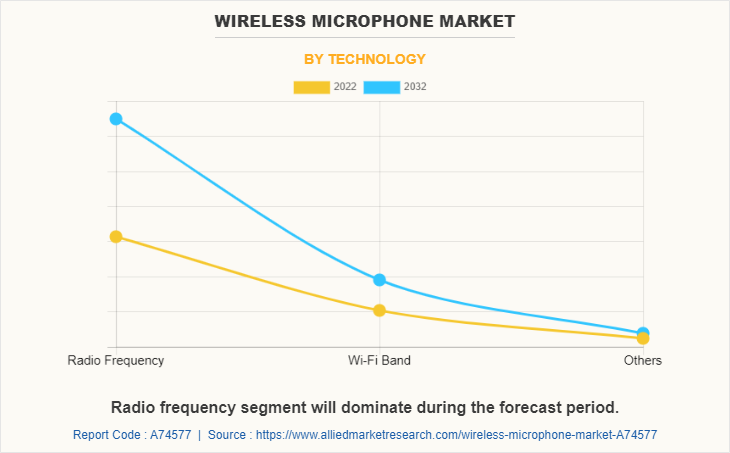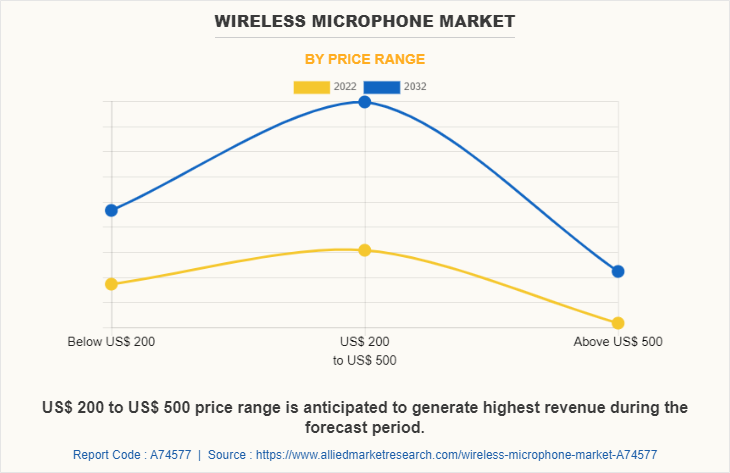Wireless Microphone Market Research, 2032
The global wireless microphone market was valued at $2.2 billion in 2022, and is projected to reach $4.4 billion by 2032, growing at a CAGR of 7.3% from 2023 to 2032.
A wireless microphone system transforms microphone-captured audio signals into radio signals. After that, the wireless mic receiver converts the signals that are sent from the transmitter into audio by capturing them as they travel through the air. It makes it possible to wirelessly transmit the desired sounds. A wireless microphone system, in contrast to a corded microphone, typically consists of three components: a microphone, a wireless transmitter, and a wireless receiver. Filmmakers, broadcasters, and streamers favor wireless microphone systems, particularly those with lavalier microphones.
They use it for a variety of reasons, the most important of which is that it keeps the frame clear without obstructing the line of sight with a handheld microphone. Another advantage of WMS is that it permits freedom of movement, which is crucial, for instance, in the educational setting. It improves student engagement in the classroom by allowing lecturers and teachers to move freely. It is beneficial for online classes as well as classroom instruction. The ability of the wireless microphone kit to free the hands is the need of many stage performers. They can sing and dance without using their hands, which makes audience interaction better. Furthermore, remote headset mics empower adaptability of development and lessen the possibility of stumbling over links. For large-scale shows, it can reduce the complexity and size of cable looms and runs.

When converting a microphone into a wireless microphone, a variety of standards, frequencies, and transmission technologies are utilized to replace the microphone's cable connection. Utilizing UHF or VHF frequencies, FM, AM, or a variety of digital modulation schemes, they can transmit. Infrared light is used in some affordable models. In contrast to more expensive radio frequency models, infrared microphones require a clear line of sight between the microphone and the receiver.
Sound is converted into electrical signals in the form of 1s and 0s by a digital or wireless system, which are stable and unaffected. However, the analog system transmits sounds as modulated radio waves, which are susceptible to interference and produce subpar audio. In addition, the compandor is expected to reduce the dynamic range, deteriorating the audio signal, which is obvious in cheap analog units. A digital system can last for an average of 40% longer as the transmitter requires less power., Moreover, as the transmission is encrypted, it is safe, and the digital system is safe from eavesdroppers. However, a suitable receiver can be used to capture analog signals.
Within a particular frequency band, each microphone's individual frequency requires a certain amount of space. The minimum distance between the frequencies of two wireless systems that are used together is determined by the system's design. Microphones compete with one another, and each system experiences noise interference and/or sound dropouts if frequencies are set too close together. As additional transmitters and collectors are added to a specific arrangement, there is development in communication between frequency augmentations. More interference frequencies are produced due to this interaction which must be avoided. Flexibility, frequency selection, and the capacity to combine more receivers and transmitters to serve more users are all features of more advanced wireless systems in wireless microphone industry.
Segment Overview
The wireless microphone market size is segmented into product type, technology, industry vertical and price range.

By product type, the wireless microphone market share is divided into handheld, clip on, plug in, and others. Handheld segment is anticipated to dominate during the forecast period.

By technology, the wireless microphone market forecast is classified into radio frequency, Wi-Fi band, and others. Radio frequency segment will dominate during the forecast period.

By industry vertical, the market is categorized into corporate, education, travel and hospitality, sports, entertainment, and others. Entertainment segment is anticipated to dominate during the forecast period due to rise in influencers, award functions, events and others.

By price range, the wireless microphone market growth is segregated into below US$ 200, US$ 200 to US$ 500 and above US$ 500. Increase in use of affordable microphones has anticipated the use of US$ 200 to US$ 500 price range microphones during the forecast period.

Region wise, the wireless microphone market trends are analyzed across North America (the U.S., Canada, and Mexico), Europe (UK, Germany, France, and rest of Europe), Asia-Pacific (China, Japan, India, South Korea, and rest of Asia-Pacific), and LAMEA (Latin America, the Middle East, and Africa). Asia-Pacific region has been anticipated to dominate during the forecast period.
Competitive Analysis
Competitive analysis and profiles of the major global Wireless Microphone market players that have been provided in the report include Honeywell International Inc., Yamaha Corporation, Knowles Electronics, Sony Corporation, RODE, Audio-Technica, MIPRO Electronics, Sennheiser Electric GmbH & Co. KG, Saramonic, and Robert Bosch GmbH.
Top Impacting Factors
One of the significant factors that impact growth of the wireless microphone industry includes rise in development of wireless connectivity. Moreover, increase in utilization of wireless microphones in the corporate and education sectors is expected to drive the market growth. However, interference and spectrum availability might hamper growth of the market. On the contrary, integration with the latest technologies offers potential growth opportunities for the wireless microphone market.
Historical Data & Information
The global Wireless Microphone market is highly competitive, owing to the strong presence of existing vendors. Vendors of Wireless Microphone market with extensive technical and financial resources are expected to gain a competitive advantage over their competitors because they can cater to market demands. The competitive environment in this market is expected to worsen as technological innovations, product extensions, and different strategies adopted by key vendors increase.
Key Developments/ Strategies
Honeywell International Inc., Yamaha Corporation, Knowles Electronics, Sony Corporation, RODE, Audio-Technica, MIPRO Electronics, Sennheiser Electric GmbH & Co. KG, Saramonic, and Robert Bosch GmbH are the top companies holding a prime share in the Wireless Microphone market. Top market players have adopted various strategies, such as product development, acquisition, innovation, partnership, and others to expand their foothold in the Wireless Microphone market.
In March 2023, RODE launched a new Rode Wireless ME system – a compact wireless microphone system designed to give professional audio for video, with minimal effort. The system has the same pocket-sized form factor as the original Wireless GO and Wireless GO II. There's a built-in GainAssist, as well as a high-quality microphone built into both the transmitter and receiver. The system is compatible with cameras, smartphones, and computers.
In January 2023, Audio-Technica expanded its range of commercial audio products with the introduction of its new Engineered Sound Wireless system. The new Engineered Sound Wireless system was created in response to the increasing demand for wireless microphone solutions for video and web conferencing. Audio-Technica's Engineered Sound Wireless system is a DECT-based wireless solution that offers simple, smart, and scalable high-quality audio.
In September 2022, Saramonic launched the Blink500 ProX wireless microphone system which is the upgraded version of the classic Blink500 Pro system. As a reliable wireless microphone system, the Blink500 ProX is not only equipped with extraordinary 2.4GHz transmission technology, a bigger OLED screen for vital information, and extra operation time but can also be used out of the box.
In March 2022, Yamaha launched a new wireless microphone option for its ADECIA family. The ADECIA Wireless conferencing solution includes the new RM-W wireless microphones, the RM-CR remote conference processor, VXL-16P Dante PoE line array speakers, and the SWR Series PoE network switch. As with other ADECIA options (ADECIA Ceiling and ADECIA Tabletop), all the components work together seamlessly to provide the most comfortable and effortless remote conferencing experience.
In April 2021, Knowles Corporation (NYSE: KN), launched two new SiSonicTM MEMS microphones for automotive applications: SPH1878 and SPH9855. The new microphones by Knowles are engineered to a higher standard of quality and supply assurance to support the increasing demands of the automotive market for hands-free calling, advanced voice assistance, and in-cabin noise cancellation for passenger comfort
In March 2021, Sony Electronics launched two new microphones of the ECM-W2BT Multi-interface, shoe-compatible wireless microphone, and ECM-LV1 compact stereo lavalier microphone, cordless mic. High-quality wireless audio recording with lower noise and stable connection is possible with the ECM-W2BT wireless microphone, especially when paired with the ECM-LV1 stereo lavalier microphone and one of Sony's cameras with digital compatibility.
Key Benefits For Stakeholders
- This report provides a quantitative analysis of the market segments, current trends, estimations, and dynamics of the wireless microphone market analysis from 2022 to 2032 to identify the prevailing wireless microphone market opportunity.
- The market research is offered along with information related to key drivers, restraints, and opportunities.
- Porter's five forces analysis highlights the potency of buyers and suppliers to enable stakeholders make profit-oriented business decisions and strengthen their supplier-buyer network.
- In-depth analysis of the wireless microphone market segmentation assists to determine the prevailing market opportunities.
- Major countries in each region are mapped according to their revenue contribution to the global market.
- Market player positioning facilitates benchmarking and provides a clear understanding of the present position of the market players.
- The report includes the analysis of the regional as well as global wireless microphone market outlook, key players, market segments, application areas, and market growth strategies.
Wireless Microphone Market Report Highlights
| Aspects | Details |
| Market Size By 2032 | USD 4.4 billion |
| Growth Rate | CAGR of 7.3% |
| Forecast period | 2022 - 2032 |
| Report Pages | 279 |
| By Product Type |
|
| By Technology |
|
| By Industry Vertical |
|
| By Price Range |
|
| By Region |
|
| Key Market Players | Honeywell International. Inc, Knowles Electronics, RODE, Yamaha Corporation, Saramonic, Robert Bosch GmbH, Sony Corporation, MIPRO Electronics, Audio-Technica Ltd., Sennheiser electronic GmbH & Co. KG |
Analyst Review
The wireless microphone market exhibited development potential across corporate, education, and entertainment sectors. Furthermore, the contribution to the worldwide market is predicted to grow considerably in the coming years. In addition, rise in adoption of wireless connectivity solutions is driving the growth of the wireless microphone market through digital transformation.
Wireless microphone market is highly competitive, owing to strong presence of existing vendors. Wireless microphone vendors invest substantially in R&D and skilled workforce and are anticipated to gain a competitive edge over their rivals. The competitive environment in this market is expected to further intensify with increase in technological innovations, product extensions, and different strategies adopted by key vendors.
The demand for wireless microphones in different sectors is estimated to expand at a rapid pace during the forecast period due to increase in prevalence of digital audio technology worldwide. The key players profiled in the report include Wireless Microphone market players, such as Honeywell International Inc., Yamaha Corporation, Knowles Electronics, Sony Corporation, RODE, Audio-Technica, MIPRO Electronics, Sennheiser Electric GmbH & Co. KG, Saramonic, and Robert Bosch GmbH.
Increasing adoption of digital wireless microphone systems, growth in the entertainment industry, and increasing demand for wireless microphones in corporate and educational settings are the upcoming trends of Wireless Microphone Market in the world.
Entertainment is the leading application of Wireless Microphone Market
Asia-Pacific is the largest regional market for Wireless Microphone.
The global wireless microphone market was valued at $2,189.5 million in 2022.
Honeywell International Inc., Yamaha Corporation, Knowles Electronics, Sony Corporation, RODE, Audio-Technica, MIPRO Electronics, Sennheiser Electric GmbH & Co. KG, Saramonic, and Robert Bosch GmbH.
Loading Table Of Content...
Loading Research Methodology...


